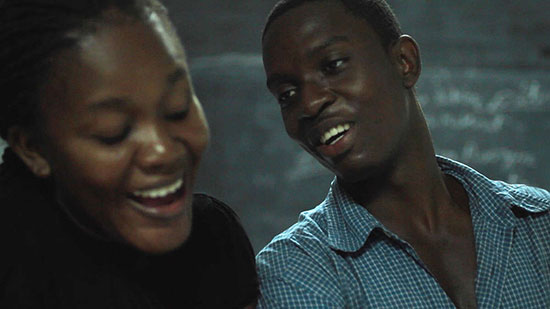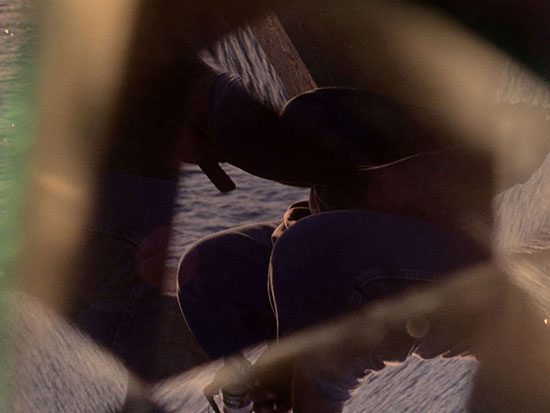Describing how she incorporates the research skills of a documentary filmmaker into her art, Beatriz Santiago Muñoz says, "You have to break the rational frame of the camera. That is why I have been playing with mirrors a lot."
Munoz explained her iconoclastic style during our interview on February 20, 2016, as we sat inside the darkened Focus Gallery at Pérez Art Museum Miami, where "Beatriz Santiago Muñoz: A Universe of Fragile Mirrors" is on view through November 13, 2016.
Throughout the gallery are jagged shadows cast on the wall by her mirror-like sculptures. The gallery also flickers with intermittent light, color and sound, thanks to the eight videos that play continuously, making it a lengthy proposition to see all of her exhibit. Four videos running on a loop are shown in a small projection room within the gallery, while others are shown on separate monitors outside the projection room.
.

"Nocturne" by Beatriz Santiago Muñoz, 2014. Digital color video, with sound, 30 min., 55 sec. Courtesy the artist and Galería Agustina Ferrreyra.
.
To experience all that she has produced, it's necessary, of course, to watch each video completely. As the videos range in length from around six to thirty minutes, this would take as much as two hours, the artist said, making "Beatriz Santiago Muñoz: A Universe of Fragile Mirrors" a complex exhibit to experience.
"Even with twenty to twenty-five minutes," the artist said, "if you spend time in the gallery looking at the projections on the outside and then walk into the projection room there is also time to get a sense of all the work together." Although she says it's not necessary to watch everything, she added, "it's not work that can be understood in fleeting images."
There's more to see than the videos: four digital chromogenic prints, two Vinyl records of audio field recordings as well as a series of geometric aluminum and glass sculptures that resemble broken mirrors make up the exhibition. By casting jagged reflections on gallery walls, they create a striking visual metaphor for Santiago Muñoz's interest in breaking and transforming conventional images of the Caribbean—and specifically, her native Puerto Rico.
Intriguing Sequel of Sorts
With its emphasis on recalibrating popular images of the Caribbean, this solo show for Santiago Muñoz, curated by María Elena Ortiz, is an intriguing sequel of sorts to the museum's 2015 group show, "Poetics of Relation," curated by Tobias Ostrander. The exhibition title refers to a classic book, which concerns the Caribbean's multicultural aesthetics and history, by Edouard Glissant of Martinique. The show brought together six artists from all over the map whose work addressed ideas about transience, diaspora and loss with vibrant metaphors, many taken from Caribbean landscape and culture.
"Poetics of Relation"also made the case for Miami, long branded as the "Gateway to Latin America," to be more fully recognized for its numerous and long-standing ties to Caribbean islands, not only to Cuba but also to Hispaniola and Jamaica. Given its geographic location, the city has become a culturally diverse, sophisticated hub with evolving ties to the Caribbean, Central and South America.
Outstanding works in "Poetics of Relation" included two riveting films with sound installations by Zarina Bhimji, a London-based Uganda-born photographer, each running close to thirty minutes. They had no overt links to the Caribbean, yet their thematic allusions were achingly consistent with the exhibit. The most recent, Jangbar, documented Kenya's now decrepit railroad system built by Indian laborers.
Melding Journalism and Art
Working with the media of film and sound, Bhimji artistically mixes the skills of a documentary journalist with a poet's selective economy of detail to produce sequential imagery of breathtaking beauty and power. Like Bhimji, Santiago Muñoz also paints a portrait of a place by updating references to a colonized past. But in contrast, Santiago Muñoz brings together a much broader sweep of thematically related details to produce works melding journalism and art.
Puerto Rico and Haiti figure prominently in her PAMM exhibit and she creates her own fresh perspective of these places. It's defiantly not indebted to stereotypical Caribbean scenes created over time by, as she explained, the United States military, the service industry and a "nostalgic agricultural memory."
"The way I start out is in a very long observational process, in which I may propose to a group of people or a person a structure or a script. Then they improvise within that," she said. Her works "are not didactic. They're not documentaries. The process is more experiential."
Shown in the gallery's projection room, MATRULLA recounts environmentally-conscious projects of Pablo Díaz Cuadro, who lives near Puerto Rico's Matrulla Lake. The video shows him walking around inside and outside his modest home, as he describes efforts to grow native plants, store ancient grain and seeds, and raise bees. He also explores activities to prepare him for a time when water and food will be scarce to nonexistent.
Also in the projection room is Marche Salomon. The video shows meat vendors, a young man and woman, chatting in Marche Salomon, a busy Port-au-Prince market. Against the surrounding bustle, the two speak matter-of-factly about the mystical qualities of products sold at Marche Salomon.
.

"Marché Salomon" by Beatriz Santiago Muñoz, 2015. Digital color video, with sound, 15 min. Courtesy the artist and Galería Agustina Ferrreyra.
.
La Cueva negra (The Black Cave) alludes to a Taino creation myth, the artist said, "in which all the beings of the universe come out of a black cave." Inside the cave they were all simple organisms, she added, but "as they come out of the cave they become bats or birds or rocks or humans."
This video shows her investigations into the layered histories of El Paso del Indio, an indigenous Taino burial site in Puerto Rico. It was discovered 20 years ago during the construction of a major freeway. To illustrate its complex past and ongoing present, she interviewed archeologists and workers active in the building of the freeway, as well as two boys from the area who like to explore the surrounding forest.
.

"La Cueva negra (The Black Cave)" by Beatriz Santiago Muñoz, 2014. Digital color video, with sound, 20 min. Courtesy the artist and Galería Agustina Ferrreyra.
.
Certainly the video La Cueva negra functions as a telling metaphor for the entire exhibit. Entering its gallery can be indeed compared to entering the obscuring darkness of a cave. At first its contents may seem indistinguishable from each other. Over time, their intricate complexity reveals itself.
But perhaps the work that most succinctly evokes the sprawling content of this exhibit is Otros usos (Other Uses). It shows panoramic ocean views from an old fuel dock that once was used by battleships of Puerto Rico's now decommissioned Roosevelt Roads US Naval Base. Currently it's a popular spot for local fishermen.
.

"Otros usos (Other Uses)" by Beatriz Santiago Muñoz, 2014. Digital color video, transferred from 16 film, with sound, 7 min. Courtesy the artist and Galería Agustina Ferrreyra.
.
'Violet Hour' of Sunset
To create its ever-changing, kaleidoscopic quality, Santiago Muñoz has used one of her Malascopios sculptures to manipulate the coastal imagery her camera captured. Otros usos is astonishingly beautiful and provocative, by turns intimate and surreal. It often appears to take place during that "violet hour" of sunset, cleverly signifying the daily transition to a new post-military period in Puerto Rico.
______________________________
BASIC FACTS: "Beatriz Santiago Muñoz: A Universe of Fragile Mirrors" is on view through November 13, 2016 in Focus Gallery of Pérez Art Museum Miami, 1103 Biscayne Blvd, Miami, FL 33132. www.pamm.org.
Additionally, the artist is featured in a residency and exhibit "Beatriz Santiago Muñoz: Song, Strategy, Sign" through June 12, 2016 at New Museum, 235 Bowery, New York, NY 10002 www.newmuseum.org.
______________________________
Copyright 2016 Hamptons Art Hub LLC. All rights reserved.
